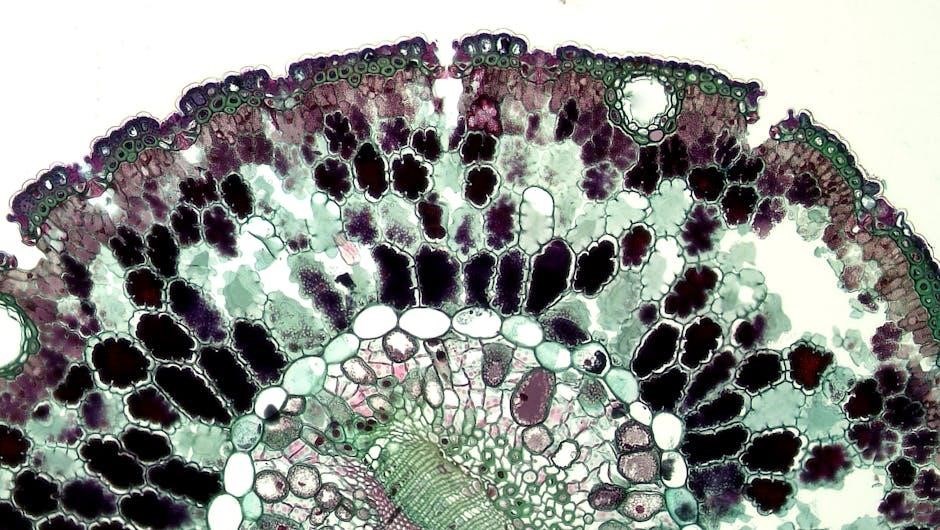Photosynthesis and cellular respiration are fundamental biological processes that sustain life on Earth. Photosynthesis converts light energy into chemical energy, while cellular respiration releases energy from organic molecules. These processes are interconnected, forming a cycle that maintains the balance of oxygen and carbon dioxide in ecosystems. Understanding these mechanisms is crucial for exploring how energy flows through living organisms and supports biological systems.
1.1 Overview of Photosynthesis and Cellular Respiration
Photosynthesis is the process by which plants, algae, and some bacteria convert light energy into chemical energy, producing glucose from carbon dioxide and water. Cellular respiration, in contrast, is the breakdown of glucose to release energy, forming carbon dioxide and water. These processes occur in specific organelles—chloroplasts for photosynthesis and mitochondria for respiration. Both involve energy conversion and are essential for life, sustaining ecosystems by cycling oxygen and carbon dioxide. Understanding their stages and interplay is vital for grasping biological energy systems.
1.2 Importance of These Processes in Biology
Photosynthesis and cellular respiration are vital for sustaining life on Earth. Photosynthesis provides the oxygen necessary for aerobic respiration and generates organic molecules that form the base of food chains. Cellular respiration powers cellular functions, enabling growth and reproduction in organisms. Together, these processes regulate Earth’s atmosphere, maintaining oxygen and carbon dioxide levels. Their interdependence underscores their critical role in energy flow and nutrient cycling within ecosystems, making them foundational concepts in biology and environmental science.
1.3 Key Differences and Interconnections
Photosynthesis and cellular respiration differ in their reactants and products but are interconnected through their roles in energy and carbon exchange. Photosynthesis occurs in chloroplasts, requiring light, CO2, and water to produce glucose and oxygen. Cellular respiration takes place in mitochondria, breaking down glucose and oxygen to release energy, CO2, and water. These processes are complementary, with photosynthesis producing oxygen used in respiration and respiration generating CO2 needed for photosynthesis, creating a balanced cycle essential for life and atmospheric stability.

Photosynthesis: An In-Depth Guide
Photosynthesis converts light energy into chemical energy, producing glucose and oxygen from CO2 and water. It occurs in plant leaves and stems, requiring sunlight. This process sustains life by providing energy and organic compounds essential for food chains and ecosystems.
2.1 Stages of Photosynthesis: Light and Dark Reactions
Photosynthesis is divided into two stages: the light-dependent reactions and the Calvin Cycle (dark reactions). The light reactions occur in the thylakoid membranes of chloroplasts, capturing light energy to produce ATP and NADPH. These molecules are then used in the Calvin Cycle, which takes place in the stroma. Here, CO2 is fixed into glucose through a series of enzyme-driven reactions. Together, these stages convert light energy into chemical energy, enabling plants to synthesize organic compounds essential for growth and energy storage.
2.2 Chloroplast Structure and Its Role
Chloroplasts are organelles found in plant cells, essential for photosynthesis. Their structure includes a double membrane, thylakoid membranes stacked into grana, and a fluid-filled stroma. The thylakoid membranes contain pigments like chlorophyll, which capture light energy to drive the light reactions. The stroma houses enzymes for the Calvin Cycle, where CO2 is fixed into glucose. This organelle is crucial for converting light energy into chemical energy, enabling plants to produce the nutrients necessary for growth and sustaining life in ecosystems.
2.3 Factors Affecting Photosynthesis (Light, CO2, Temperature)
Photosynthesis is influenced by light intensity, CO2 concentration, and temperature. Light intensity directly affects the rate of photosynthesis, with higher light often increasing production until saturation occurs. CO2 availability impacts the Calvin Cycle, with higher concentrations enhancing photosynthesis up to a point. Temperature affects enzyme activity, with optimal ranges varying among plant species. These factors interact, and suboptimal conditions in one can limit the process, even if others are favorable. Understanding these factors is essential for optimizing plant growth and agricultural productivity.

Cellular Respiration: A Comprehensive Overview
Cellular respiration is the process by which cells break down glucose to release energy, occurring in leaves, roots, and stems. It is essential for plant metabolism.
3.1 Stages of Cellular Respiration: Glycolysis, Krebs Cycle, Electron Transport Chain
Cellular respiration involves three main stages: glycolysis, the Krebs cycle, and the electron transport chain. Glycolysis breaks down glucose into pyruvate, producing a small amount of ATP.
The Krebs cycle converts pyruvate into acetyl-CoA, generating more ATP, NADH, and FADH2.
The electron transport chain uses these molecules to produce a large amount of ATP through oxidative phosphorylation.
Together, these stages efficiently release energy stored in glucose, powering cellular functions.
3.2 Mitochondria: The Powerhouse of the Cell
Mitochondria are often called the powerhouse of the cell because they generate most of the energy required for cellular functions through ATP production. These organelles have a double membrane structure, with the inner membrane folded into cristae to increase surface area for energy production. Mitochondria are the site of the Krebs cycle and the electron transport chain, processes that convert glucose into ATP through oxidative phosphorylation. Their efficient energy production is essential for sustaining life in aerobic organisms, making them a critical component of cellular respiration.
3.3 Aerobic vs. Anaerobic Respiration
Aerobic respiration occurs in the presence of oxygen and involves the breakdown of glucose into carbon dioxide and water, releasing a significant amount of energy. It includes glycolysis, the Krebs cycle, and the electron transport chain. Anaerobic respiration, in contrast, occurs without oxygen and produces less energy, resulting in byproducts like lactic acid or ethanol. Aerobic respiration is more efficient and is the primary energy source for most organisms, while anaerobic respiration serves as a backup when oxygen is scarce. Both processes are vital for cellular energy production.

Interrelationship Between Photosynthesis and Cellular Respiration
Photosynthesis and cellular respiration are interconnected processes that sustain life. Photosynthesis produces oxygen and glucose, while cellular respiration uses these to release energy, creating a mutually dependent cycle.
4.1 The Cycle of Oxygen and Carbon Dioxide
Oxygen and carbon dioxide are exchanged between photosynthesis and cellular respiration, forming a vital cycle. In photosynthesis, carbon dioxide is absorbed and oxygen is released. Conversely, cellular respiration consumes oxygen and emits carbon dioxide. This continuous exchange sustains life, maintaining atmospheric balance. The processes are interdependent, ensuring ecosystems function efficiently. This cycle highlights the intricate relationship between producers and consumers, underpinning energy flow and nutrient circulation in nature.

4.2 Energy Flow in Ecosystems
Energy flows through ecosystems via food chains and webs, with photosynthesis as the primary energy source. Producers capture sunlight, converting it into chemical energy stored in organic molecules. This energy is transferred to herbivores and then to carnivores, with each trophic level retaining only a fraction of the previous level’s energy. Cellular respiration releases energy from these molecules, returning it to the environment. This flow sustains ecosystem balance, ensuring survival across all biological communities while maintaining the Earth’s energy cycle.

Comparing and Contrasting Photosynthesis and Cellular Respiration
Both processes involve energy conversion and gas exchange but differ in purpose. Photosynthesis produces energy, while respiration releases it. They are vital for life, interconnected yet distinct.
5.1 Reactants and Products
Photosynthesis and cellular respiration are mirror-image processes. Photosynthesis uses carbon dioxide (CO₂) and water (H₂O) to produce glucose (C₆H₁₂O₆) and oxygen (O₂). In contrast, cellular respiration breaks down glucose and oxygen to release carbon dioxide, water, and energy (ATP). The reactants of one process are the products of the other, showcasing their interdependence. This reciprocal relationship highlights their critical roles in energy conversion and gas exchange, essential for sustaining life and ecosystems.
5.2 Energy Transformation in Both Processes
Photosynthesis and cellular respiration involve the transformation of energy between different forms. In photosynthesis, light energy is converted into chemical energy stored in glucose during the Calvin cycle. Conversely, cellular respiration releases chemical energy from glucose and converts it into ATP through glycolysis, the Krebs cycle, and the electron transport chain. While photosynthesis captures energy from sunlight, respiration releases it for cellular functions. Both processes are efficient but serve opposite purposes, ensuring energy flow and storage in living organisms and ecosystems. Their interdependence underscores the balance of energy transformation in nature.

Equations and Diagrams
Photosynthesis and cellular respiration are visually represented through balanced equations and detailed diagrams. These tools illustrate the conversion of energy and materials, aiding in comprehensive understanding.
6.1 Balanced Chemical Equations for Both Processes

The balanced chemical equation for photosynthesis is:
6CO2 + 6H2O + light → C6H12O6 + 6O2. For cellular respiration, the equation is:
C6H12O6 + 6O2 → 6CO2 + 6H2O. These equations show the interconversion of energy and matter, emphasizing the reciprocal relationship between the two processes. Understanding these equations is essential for grasping how energy is transformed and exchanged in biological systems. They form the foundation for analyzing the biochemical pathways involved in both processes.
6.2 Visual Representation of Light and Dark Reactions
A visual representation of the light and dark reactions in photosynthesis provides a clear understanding of their sequences and interactions. The light reactions, occurring in the thylakoid membranes, are depicted as the process where light energy is absorbed, water is split, and ATP and NADPH are produced. The dark reactions, or Calvin cycle, are illustrated in the stroma, showing how CO2 is fixed into glucose using the ATP and NADPH from the light reactions. These diagrams highlight the spatial and functional relationship between these two stages, making the process easier to comprehend and study.

Experiments and Applications
Experiments measuring photosynthesis rates and CO2 effects provide insights into environmental impacts. Practical applications in agriculture and ecology optimize crop yields and ecosystem management, enhancing sustainability and food production.
7.1 Measuring the Rate of Photosynthesis
Measuring photosynthesis involves tracking oxygen release or carbon dioxide uptake. Common methods include floating leaf disk assays, where disks submerged in bicarbonate solution measure gas exchange. Videos and guides demonstrate these techniques, showing how environmental factors like light intensity and CO2 levels affect rates. Sensors and gas exchange systems provide precise measurements for advanced studies. These experiments help understand how plants respond to varying conditions, offering insights into optimizing crop growth and ecological balance.
7.2 Investigating the Effects of CO2 on Photosynthesis
7.2 Investigating the Effects of CO2 on Photosynthesis
CO2 is a critical reactant in photosynthesis, and its concentration significantly impacts the process; Experiments often involve measuring oxygen release or carbon uptake under varying CO2 levels. Leaf disk assays submerged in bicarbonate solutions demonstrate how CO2 availability affects photosynthetic rate. controlled studies show increased CO2 enhances photosynthesis up to a point, beyond which other factors like light intensity become limiting. These investigations provide insights into how plants respond to environmental changes, such as rising atmospheric CO2 levels, and their implications for agriculture and ecology.
7.3 Practical Applications in Agriculture and Ecology
Understanding photosynthesis and cellular respiration is vital for improving agricultural practices and ecological sustainability. By optimizing light, water, and CO2 levels, farmers can enhance crop yields. In greenhouses, controlled atmospheric conditions maximize photosynthetic efficiency, boosting plant growth. Ecologically, these processes inform strategies to mitigate climate change by managing carbon cycles and preserving biodiversity. Practical applications also include developing energy-efficient systems and bioproducts, showcasing the importance of these biological processes in real-world scenarios.
Photosynthesis and cellular respiration are vital processes sustaining life, enabling energy conversion and ecological balance. Their interconnection ensures the continuous cycle of oxygen and carbon dioxide, supporting life on Earth.
8.1 Summary of Key Concepts
Photosynthesis and cellular respiration are essential biological processes that sustain life. Photosynthesis occurs in plant leaves and stems, converting light energy into chemical energy through glucose production. Cellular respiration breaks down glucose to release energy, occurring in roots, stems, and leaves. These processes are interdependent, exchanging oxygen and carbon dioxide. Understanding their mechanisms and interconnections is vital for grasping energy flow in ecosystems and the survival of living organisms.
Both processes highlight the delicate balance of energy transformation and nutrient cycling, ensuring life’s continuity.
8.2 Significance of These Processes in Biological Systems
Photosynthesis and cellular respiration are vital for sustaining life on Earth. Photosynthesis generates oxygen and organic molecules, forming the foundation of food chains and ecosystems. Cellular respiration provides energy for cellular functions, ensuring the survival of organisms. Together, they maintain the carbon cycle and regulate Earth’s atmosphere. These processes highlight the interdependence of life forms and the continuous flow of energy through biological systems, underscoring their critical role in maintaining ecological balance and supporting all living organisms.
